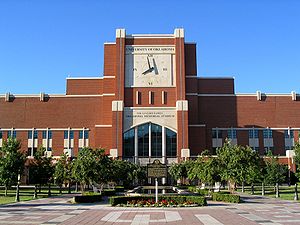Gaylord Family Oklahoma Memorial Stadium
| Gaylord Family Oklahoma Memorial Stadium | |
|---|---|
| Owen Field | |

|
|
| The Gaylord Family Oklahoma Memorial Stadium in Norman | |
| Earlier names | |
|
|
| Data | |
| place | 180 East Brooks Street Norman , Oklahoma 73019
|
| Coordinates | 35 ° 12 '21.2 " N , 97 ° 26' 33" W |
| owner | University of Oklahoma |
| operator | University of Oklahoma |
| start of building | 1921 |
| opening | October 20, 1923 |
| First game | October 20, 1923 University of Oklahoma- Washington University 62: 7 |
| Renovations | 1980, 1997, 2003, 2016 |
| Extensions | 1925, 1929, 1949, 1957, 1974, 1980, 2003, 2016 |
| surface |
Natural grass : 1923-1969, 1994 artificial turf : 1970-1993 |
| costs | $ 293,000 (1923) |
| capacity | 83,489 places (from 2016) 82,112 places (2004–2015) 81,207 places (2003) 72,765 places (1998–2002) 75,004 places (1984–1997) 75,008 places (1980–1983) 71,187 places (1975–1979) 61,836 places (1963 –1974) 61,724 places (1957–1962) 55,647 places (1949–1956) 32,000 places (1929–1948) 16,000 places (1925–1928) |
| Societies) | |
|
|
The Gaylord Family Oklahoma Memorial Stadium is an American football - stadium on the campus of the University of Oklahoma in the US American City Norman in the state of Oklahoma . It serves as the venue for the home games of the Oklahoma Sooners college football team . After the expansion of the southern end zone for the 2016 season, the stadium will have a capacity of 83,489 spectators. The attendance record of 86,031 was set in 2012 in a game against Notre Dame .
history
The first game at the stadium's current location was played in 1923 when the Sooners beat Washington University 62-7. When 16,000 permanent seats were built on the site's west side in 1925, the stadium was named after the Oklahoma Memorial Stadium , in honor of the university's students and staff who died during World War I. The construction costs amounted to approximately 293,000 US dollars and trainer Bennie Owen himself helped the money to be found. To honor his efforts, the pitch was named after Owen Field and traditionally this has become the stadium's nickname.
In 1929 permanent seats were also added on the east side. In 1949 the north side of the stadium was closed, the playing area was lowered by 2 m and a running track was created around the playing field. The audience capacity was now 55,000. Additional seats at the end zone south increase this further to 62,000 in 1957. In 1970 the natural grass was replaced by artificial grass . On the west side, an upper deck with a press box and box seats was finally added in 1975 and the capacity increased to 71,187. Apart from the play area and the floodlights , this was the last expansion in over 25 years. In 1994 they returned to the natural grass field.
At the turn of the millennium, the over 75-year-old stadium was in poor condition. In 2000, the Sooners won the national championship again, and extensive renovations for $ 54 million were made by 2003. Among other things, all seats were renewed and new video and audio systems were installed. The capacity increased again to today's 82,112. In addition to the stadium, some new facilities were also built. Of the total cost of $ 75 million, 12 million was donated by Christy Gaylord Everest , editor of The Oklahoman newspaper . The stadium was therefore renamed in her honor in 2002.
gallery
Halftime show at the Oklahoma Sooners game against the UAB Blazers on September 2, 2006
See also
Web links
- soonersports.com: stadium on the site of the sports department of the University (English)
- skyscrapercity.com: site for the expansion of the stadium (English)
- gfoms.com: Construction site webcam (English)
Individual evidence
- ↑ tulsaworld.com: OU Sports: Oklahoma's home game against Ohio State officially a sellout article from July 21, 2016 (English)
- ↑ Football - Oklahoma Memorial Stadium ( en ) In: Soonersports.com . University of Oklahoma . September 8, 2003. Retrieved April 30, 2009.
- ↑ Jay C. Upchurch: A Towering Achievement (en) . In: Sooner Magazine , The University of Oklahoma Foundation, Fall 2003. Archived from the original on October 17, 2007. Retrieved April 30, 2009.



